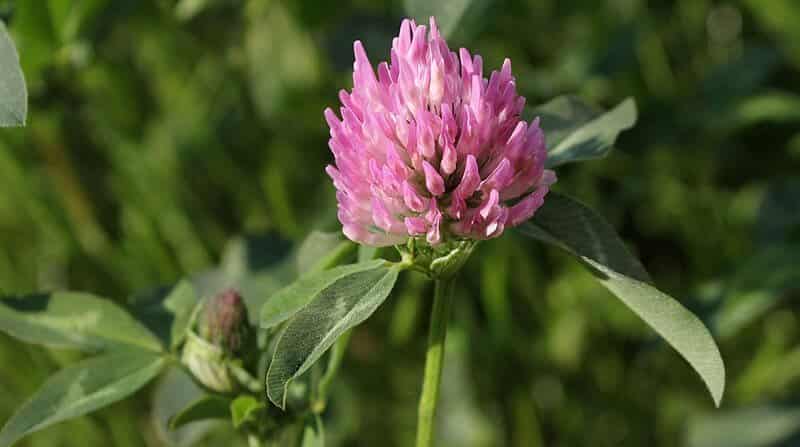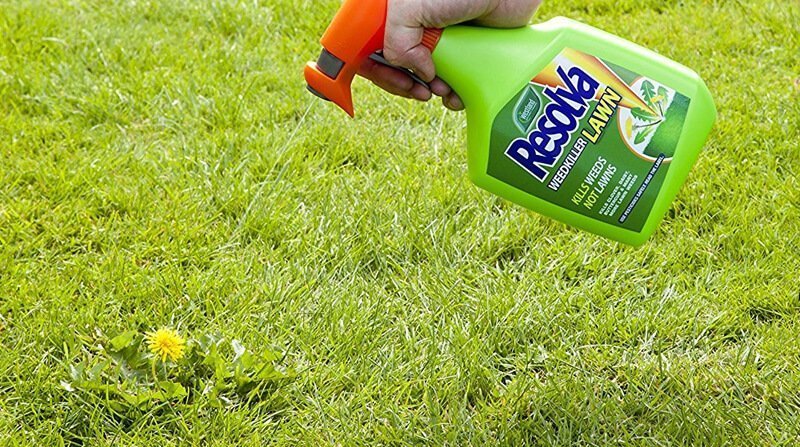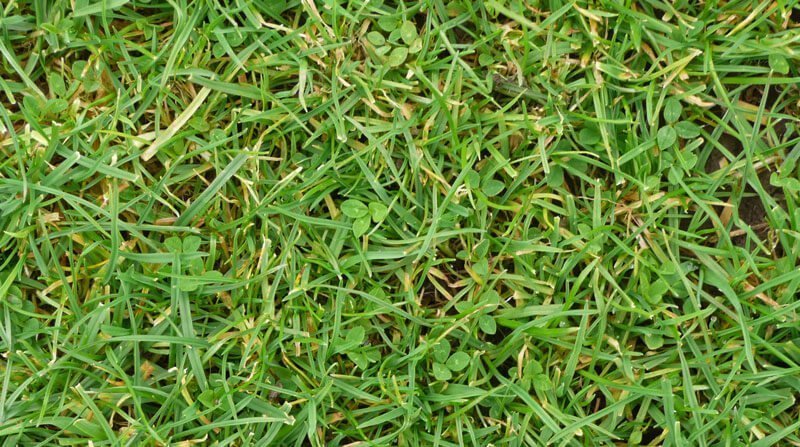Clover in lawns can be a major headache for many gardeners.
In dry summer months, Clover, Medic and Trefoil stand out with their bright green patches against the paler grass.
This looks horrible!
There are a few types of Clover, including;
- White Clover
- Red Clover
- Lesser Trefoil
- Birds Foot Trefoil
- Black Medick
Although the most common are White Clover and Lesser Trefoil.
The presence of Clover in your lawn it is most commonly a symptom of nutrient deficient soil. Water shortage can also be a cause.
Whichever Clover inhabits your lawn, the process for removing them is the same. This article will not only show you how to get rid of it but also how to prevent it from growing back.
Clover in a Nutshell
As I said earlier, there are a few different types of Clover and each one has their own characteristics.
White Clover

White Clover or Trifolium repens is also known as Dutch Clover.
It grows close to the ground via runners which creep along the surface (called Stolons). These Stolons form roots at intervals and grow new plants.
The leaves are typical of Clover with each leaf having three leaflets, each one with a distinctive white, V-shaped band across it.
The flowers bloom between June and September and are generally white but sometimes pinkish with a brownish or green centre.
Red Clover

Red Clover or Trifolium pratense is similar to White Clover but there are distinct differences between the two;
Firstly, White Clover has much rounder leaves. The leaves on Red Clover are narrower and pointed, although they do have the distinctive V-shaped band.
The most obvious way to tell them apart though is by the flowers. The shape is very similar but White Clover has white flowers, Red Clover had red (or pinkish) flowers.
Rocket science, I know!
Also, while White Clover grows close to the ground, Red Clover can reach 20 inches in height, if allowed to grow.
Lesser Trefoil & Black Medic

Lesser Trefoil or Trifolium dubium is also known as Yellow Suckling Clover. It is often mistaken for Black Medick or Medicago lupulina.
They both have leaves which consist of three leaflets which grow on short stalks, unlike White or Red Clover on which there are no stalks.
However, the leaves on Lesser Trefoil have smooth edges as opposed to Black Medic which has slightly jagged edges.
There isn’t much difference between the flowers either as they’re both yellow and are very similar in shape. Oftentimes, the only way you can tell them apart just by looking at the flowers is at the end of the season. The flowers on Lesser Trefoil turn brown whereas, on Black Medick, they turn black.
They also flower at slightly different times. Lesser Trefoil generally flowers between May and October, Black Medic blooms between April and August.
The video below from Maxwell Amenity shows the difference between Lesser Trefoil and Black Medic;
Birds Foot Trefoil

As with all clovers, Birds Foot Trefoil or Lotus corniculatus has three leaflets at the tip of the stalk. This particular species also has two more leaflets at the base of the stalk. If left to grow, the stalks can grow as long as 40cm.
The flowers are yellow and look similar to Honeysuckle but sometimes have a red streak which is where their nickname ‘Eggs and Bacon’ comes from. They’re generally seen between April and September.
Birds Foot Trefoil differs from other Clover species in that each plant is anchored by a deep taproot, similar to Smooth Hawks Beard.
Weed or Wildflower
Clover is a perennial wildflower which you’ll see in meadows all across the UK.
It’s a perennial plant, which means it’ll come back year after year.
Because they’re a wildflower, they grow in a range of soil types but prefer medium to alkaline soils that are low in nitrogen. Lawns that lack nitrogen usually lack healthy grass which makes them the perfect place for Clover to spread.
And they spread quite aggressively.
Some people actually like Clover in their lawns but many don’t. So despite it actually being a wildflower, most gardeners consider it a weed and a symptom of a less than a perfectly healthy lawn.
But at the end of the day, your garden is a place for you to express yourself freely. If you like them, keep them.
If not I’ll show you how to get rid of them and prevent them from returning.
How to Remove Clover From Your Lawn
If like most gardeners you don’t want to see Clover taking over your lawn and you want to get rid of it, you have a few options;
Remove it by Hand
If there’s not much Clover in your lawn, try removing it by hand with a weed removal tool, trowel or hand fork.
Be careful when removing Birds Foot Trefoil though. It grows from a deep taproot which if not removed completely, can grow back from just a fragment.
Kill it With a Selective Spot Spray Weed Killer

If it has returned in one or two places after removing the majority of it by hand, try using a selective spot spray weed. Selective weed killers will kill the majority of weeds while being gentle on the grass.
Resolva Lawn Weed Killer Spot Spray is probably the best you can get for killing most species of clover.
- Small spray bottle ideal for small areas
- Non-glyphosate formulation
Treat the Whole Lawn With a Selective Weedkiller Concentrate
If Clover is running amock in your lawn along with other weeds like Dandelions and Daisies, then spot treatment isn’t the best idea.
Instead, you’ll need to treat the whole lawn with a selective weedkiller concentrate like Scotts Weedol Lawn Weedkiller Concentrate. Again, this is your best option for killing Clover, as well as other weeds.
It’s is designed to be mixed with water and applied using a watering can or knapsack sprayer.
When using weedkiller concentrates, however, you need to read the instructions carefully and dilute it accurately. Make it too strong and you risk killing the grass but diluting it too much could result in the weeds not dying.
- Apply through a sprayer or watering can
- Non-glyphosate formulation
Read: How to Choose the Best Weed Killer For Your Lawn
How to Prevent Clover From Returning
If you have Clover in your lawn, chances are you have other lawn weeds growing in too. This is a classic sign that your lawn isn’t as healthy as it could (or should) be.
Killing and removing weeds is only half the battle. If you don’t take steps to improve the health of your lawn they will quickly grow again. Sometimes the same weeds will inhabit the soil, other times you’ll find new ones popping up.
By keeping your lawn healthy with a dense covering of grass, weeds will have no room to germinate and grow and your lawn will look beautiful all the time.
Here are the steps you need to take to keep your lawn healthy;
Cut the Grass Often

This is by far the most important part of lawn care.
Cut your grass regularly.
When growth conditions are at their best in spring and autumn cut the grass at least once a week. In the summer when growth slows down, cut it at least once every two weeks. Once every ten 10 days is best.
Cutting the grass regularly prevents it from growing upwards and forces it to sprout sideways and grow new leaves. This results in a denser covering of grass which means less room for weeds.
A big mistake people make when mowing the lawn is to cut the grass too short. By raising the cutting height of your lawnmower, the grass will be slightly longer but it starves any weed seeds of the light they need to germinate and grow.
Read: How to Mow the Lawn Like a Pro: Everything You Should Know About Grass Cutting
Scarify Your Lawn to Remove Excess Thatch

Thatch is a spongy layer that sits between the grass and soil. It’s made up living and dead organic material, predominantly dead grass roots and leaves.
Having some thatch in your lawn is a good thing because it protects the crown of the grass plant from damage and disease. However, too much can also prevent air, water and nutrients from reaching the soil.
This means the roots of the grass can’t absorb the necessary ingredients to produce food and grow.
This results in a patchy lawn which is prime real estate for weeds like clover to invade.
Scarifying your lawn will remove much of this thatch and open up the soil so water, air, and nutrients can penetrate it.
In turn, the grass can consume it, produce food and grow strong and spread, creating less room for clover and trefoils to germinate.
Reduce Soil Compaction By Aerating Your Lawn

Compacted soil is the result of heavy lawn use.
Kids and pets playing on it through the summer is a prime example of this.
The forces put through during times of heavy use cause the soil particles to be pressed together, squeezing out air and water. It also prevents them, along with other nutrients from penetrating the soil so the grass can’t get what it needs to grow and survive.
Other areas of your lawn are also prone to compaction, like around the washing line, if you have garden furniture on your lawn or the route that your postman takes to the front door.
Aerating your lawn relieves compaction and create space in the soil for air, water and nutrients to penetrate.
Read: Lawn Aeration: Everything You Need to Know About Aerating Your Lawn (The Ultimate Guide)
Fertilise Your Lawn with a Good Quality Fertiliser

Clover in your lawn is often a sign that it’s low in nutrients, especially Nitrogen.
Soil can become deficient in nutrients for a few reasons;
-
- You don’t apply a fertiliser
- Your lawn is thick with thatch and nutrients can’t get through, or
- The soil is compacted so nutrients can’t penetrate it.
Many beginner gardeners apply fertiliser to their lawns and complain that it doesn’t work.
What they fail to understand is that when their lawn is thick with thatch and the soil is compacted the nutrients in the fertiliser can’t penetrate into the soil. It just sits above the surface and has no effect at all.
If your lawn is thick with moss and weeds, scarify and aerate it. Then apply a good quality fertiliser. You only need to scarify once every year or two and aerate in the spring and autumn.
Just one application of a good quality, slow-release fertiliser will improve the health of your lawn immeasurably. It’ll promote good grass growth causing the grass to outcompete the weeds.
Read: Lawn Fertiliser: What, Why, When and How to Feed Your Lawn
Also Read: Best Lawn Feed: Reviews of Popular Products & Complete Buyers Guide
Now it’s Over to You
Like most weeds, killing and removing Clover is a fairly simple process.
Keeping it at bay is a little more involved. It seems like a lot of work but it really isn’t.
Just;
- Mow your lawn regularly.
- Scarify every couple of years in the autumn.
- Aerate in the Spring and/or Autumn.
- Give your lawn at least one application of fertiliser per year, and
- Spot spray any weeds that might make an appearance.
That’s all there is to it.
If you have any questions or suggestions let me know in the comments.
I’d also love to see your before and after pictures so if you have them, send them in and all share them with our community.




Best advice I’ve had yet, Tim, on how to control weeds. Thanks!